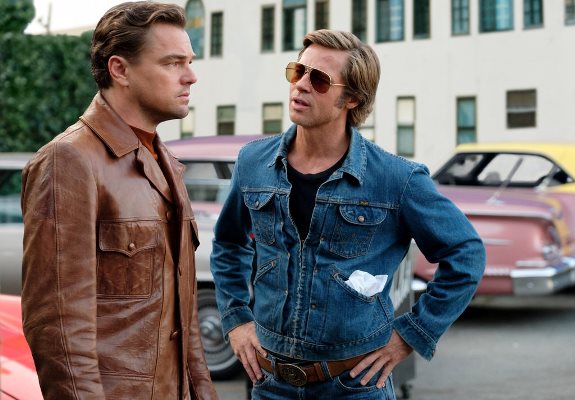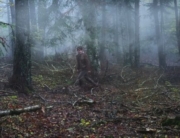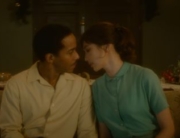
Leonardo DiCaprio, left, and Brad Pitt in Once Upon a Time … in Hollywood (Andrew Cooper/Sony Pictures)
![]() Quentin Tarantino, in his most exuberant and, believe it or not, minimalist film, riffs on late-1960s Hollywood history, a few days in February and August of 1969, to be exact. Given the period and setting, Charles Manson and his followers lurk in the background with some of the young women in his “family” sometimes getting a close-up.
Quentin Tarantino, in his most exuberant and, believe it or not, minimalist film, riffs on late-1960s Hollywood history, a few days in February and August of 1969, to be exact. Given the period and setting, Charles Manson and his followers lurk in the background with some of the young women in his “family” sometimes getting a close-up.
Those who have had nightmares after reading Vincent Bugliosi and Curt Gentry’s Helter Skelter, rest easy. Though it has plenty of ominous undertones, this is a buddy movie centering on a fading TV star and his stunt double/Jack-of-all-trades that’s more in the buoyant spirit of the era-appropriate Butch Cassidy and the Sundance Kid, mixed with the old-school sentiments of Dirty Harry; the word “hippie” is also a pejorative here.
Tarantino’s Tinseltown is a city of contrasts, between those who are on the rise and those fading fast, between the stars up in the Hollywood Hills and the working class down in the industrial flatlands, and between the establishment and the boy wonder filmmakers, such as Roman Polanski (who appears briefly, played by Rafal Zawierucha). Yet this is a fantasyland version of the City of Angels. The Watts riots of 1965 are in the rearview mirror. An extended sequence of Brad Pitt driving in a white convertible down a traffic-free highway under baby blue skies recalls Joan Didion’s description of Southern California living in her novel Play It as It Lays, as her main character, Maria, cruises on the city’s freeways with the radio blaring, as though she has complete freedom.
About Tarantino’s plot, the less you know the better. One of the pleasures of the movie is having no idea where it’s headed. It has a loosely connected structure that does not adhere to a rigid construction. One could say that the first two hours are all buildup, exposition to a riveting final act.
The script and the production design hint of the film industry’s bumpy transition from the fading studio system to the arrival of New Hollywood. A sign of the older times are the backlot billboards for the musical Funny Girl and the upcoming epic Tora! Tora! Tora!, the type of big-budget road shows that would fall out of fashion within a few years.
Heavy drinking Rick Dalton (Leonardo DiCaprio, in a role sending up actors’ insecurities) has been around the block several times. His western TV series was cancelled when he left to pursue a career on the big screen, and now he’s back on the boop tube, making guest star appearances as the go-to heavy. If Rick stands in for many actors, the one that rings the most bells is Clint Eastwood, who, like Rick, made his mark in the series Rawhide before gaining traction overseas in spaghetti westerns—or Ty Hardin. To see Harden at work, catch one of the repeated airings on the Movies! digital channel of Berserk!, the garish 1967 thriller in which he plays Joan Crawford’s boy toy.
Since the film’s premiere at Cannes, Tarantino has added two more minutes of Margot Robbie as Sharon Tate, the most famous victim of the Manson family’s August 1969 murder spree. As a character, she remains a purposefully elusive and ephemeral presence, flitting throughout the film: she happens to live next door to Rick. One could argue that the Tate portrayed here is similar to the real-life actress: the idealized California Golden Girl, whose good looks dominated others’ perceptions of her, as well as forming the basis of her career. Tarantino’s Tate wins the award for the least loquacious main character in the director’s oeuvre. However, with or without lines, Robbie is luminous and vulnerable in the telling moments when she’s the center of attention, such as when she buys a first edition of Thomas Hardy’s Tess of the D’Urbervilles for her director husband. Polanski faithfully adapted the novel in his 1979 film Tess.
Once again, life is a B-movie in Tarantino’s universe. Some sequences could have been outtakes from Inglourious Basterds. However, this time, the end result is actually sweet and coolly sentimental. That’s not to say Tarantino has mellowed. He can’t help but go over-the-top in one sequence in particular, as though it wouldn’t be a Tarantino movie without a certain sort of mayhem.
The dialogue is more naturalistic and less self-aware than in most of his films; the cast doesn’t have to keep up with a certain rhythm or lingo, which suits DiCaprio and Pitt’s laidback vibe. The movie’s in-the-know crowd will be film buffs of the period, those who have a flirtation with pop culture of the free-for-all sixties, and undoubtedly those who know the history of Manson and his devotees. For those who want to take a deep dive into the backstory of the sprawling Spahn Ranch, where the Manson family lived and which features prominently here, a great place to start is Karina Longworth’s in-depth, 10-part “Charles Manson’s Hollywood” series on her You Must Remember This podcast.
The movie zips along without any bumps for the first 75 minutes or so. As in The Hateful Eight, the mid-section sags a bit. Yet there’s an important payoff as the pace slows down and the roving camera stays fixated on Rick as he’s filming a TV pilot, playing again a bad guy, and hits a wall, tripping on his lines. Tarantino allows DiCaprio a showcase moment, namely a meltdown in his trailer. Though the director’s rendering of history in this movie and Inglourious Basterds is of his own making, his characters are convincingly made of flesh and blood.
















love leonardi di caprio